
(Download a higher resolution picture by clicking on any
picture below. The photographs on the right side of the page were
taken by the photographers of the NASA
Dryden Flight Research Center.) 
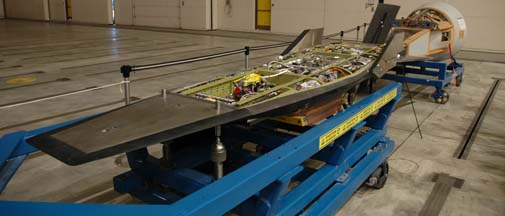 The third X-43A being prepared for flight on March 27.
The Pegasus booster of the third X-43A Hyper-X vehicle contained the
full propellant load of the standard model in order to reach
Mach-10.
The booster adapter in the background has been manufactured from
aluminum instead of
steel to reduce the weight of the stack.
The third X-43A being prepared for flight on March 27.
The Pegasus booster of the third X-43A Hyper-X vehicle contained the
full propellant load of the standard model in order to reach
Mach-10.
The booster adapter in the background has been manufactured from
aluminum instead of
steel to reduce the weight of the stack.
The weather at Edwards Air Force Base could not have been more perfect for the third flight of the X-43A Hyper-X. There was almost no wind and the air temperature was in the sixties.
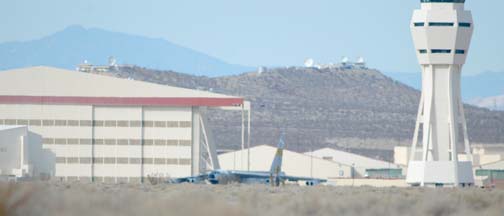 NASA's
Boeing NB-52B Stratofortress mothership taxied out with the X-43A Stack.
NASA's
Boeing NB-52B Stratofortress mothership taxied out with the X-43A Stack.
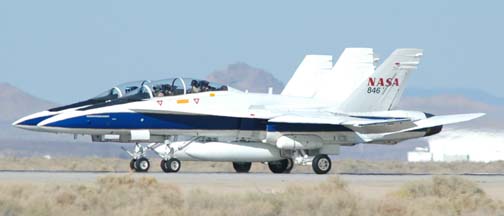 NASA McDonnell-Douglas F/A-18B Hornet chase planes
N846NA and N852NA took-off from Runway 22 a few minutes before the NB-52B carrying the
X-43A began its take-off roll.
NASA McDonnell-Douglas F/A-18B Hornet chase planes
N846NA and N852NA took-off from Runway 22 a few minutes before the NB-52B carrying the
X-43A began its take-off roll.
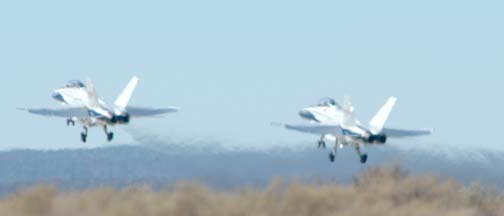 The Hornets were piloted by Dana Purifoy and Dick Ewers.
In the back seats of the Hornets, Jim Ross shot video and Carla Thomas shot still photographs.
The Hornets were piloted by Dana Purifoy and Dick Ewers.
In the back seats of the Hornets, Jim Ross shot video and Carla Thomas shot still photographs.
The Hornets turned around and approached from the west. The first indication that the NB-52B had begun rolling was a dense cloud of sooty smoke on the horizon.
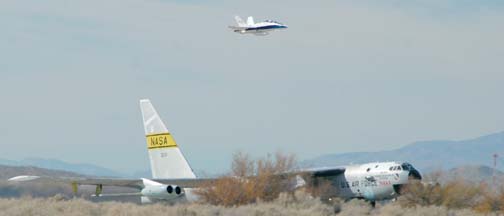 The F/A-18Bs caught up with the NB-52B just as it rotated.
The F/A-18Bs caught up with the NB-52B just as it rotated.
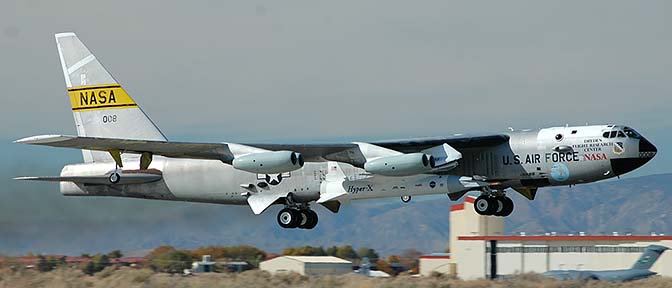 The NB-52B Stratofortress mothership lifted the
X-43A from Runway 04 shortly after 1:00 P.M. It was piloted by former Space Shuttle pilot
C. Gordon Fullerton. The co-pilot was Frank Batteas, who had flown one of the F/A-18B chase
planes on the Mach-7 mission last March. Orbital Sciences employee Brian Minnick
manned the launch panel and NASA Dryden's Brad Neal monitored the
X-43A systems aboard the NB-52B.
The NB-52B Stratofortress mothership lifted the
X-43A from Runway 04 shortly after 1:00 P.M. It was piloted by former Space Shuttle pilot
C. Gordon Fullerton. The co-pilot was Frank Batteas, who had flown one of the F/A-18B chase
planes on the Mach-7 mission last March. Orbital Sciences employee Brian Minnick
manned the launch panel and NASA Dryden's Brad Neal monitored the
X-43A systems aboard the NB-52B.
Link to the NASA Dryden biography for C. Gordon Fullerton.
Link to the NASA Dryden biography for Frank Batteas.
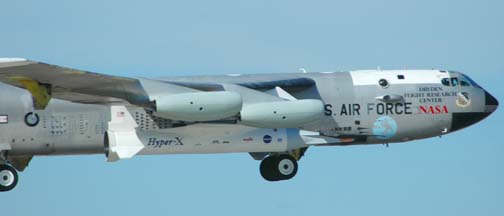 The X-43A was propelled to its operating speed and
altitude by a modified Orbital Sciences Pegasus booster.
The X-43A was propelled to its operating speed and
altitude by a modified Orbital Sciences Pegasus booster.
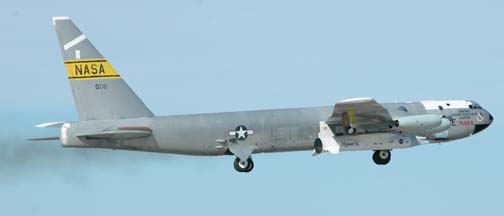 The main landing gear trucks of the NB-52B rotated
as they retracted
into the fuselage. Castle Butte, familiar to viewers of X-15 landing films, is visible in the
background of the larger version of the photo.
The main landing gear trucks of the NB-52B rotated
as they retracted
into the fuselage. Castle Butte, familiar to viewers of X-15 landing films, is visible in the
background of the larger version of the photo.
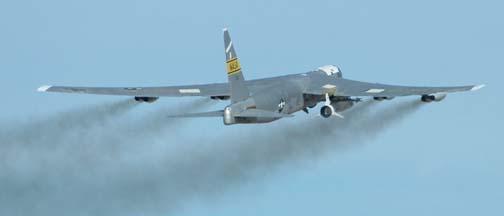 Pilot C. Gordon Fullerton made a hot take-off, pulling the
NB-52B mothership into a steep climb after lift-off.
Pilot C. Gordon Fullerton made a hot take-off, pulling the
NB-52B mothership into a steep climb after lift-off.
 After climbing a few thousand feet, the NB-52B pitched over into
a shallower climb.
After climbing a few thousand feet, the NB-52B pitched over into
a shallower climb.
It took a little more than an hour for the NB-52B to get into position for launch, over the Pacific Ocean about 110 miles southwest of Santa Barbara. The NB-52B launched the Hyper-X stack at an altitude of 40,000 feet, heading due west. The stack dropped for five seconds before the Pegasus booster ignited.
The Pegasus booster climbed to 110,000 feet and accelerated to Mach 9.8 in about 90 seconds and then released the X-43A. Once it was established that the X-43A was in stable flight, the engine cowl doors opened. Hydrogen fuel was injected into the combustion chamber and ignited with Silane. Combustion was maintained in the airflow going faster than the speed of sound through the engine. The thrust of the engine was approximately equal to the drag of the vehicle, simulating cruise flight, for ten seconds. The X-43A flew twenty miles in those ten seconds.
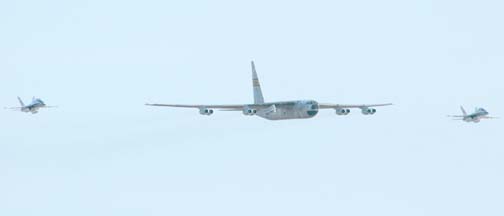 NASA's
Boeing NB-52B Stratofortress mothership was flanked by the two white and blue Hornet chase
planes as it approached the NASA Dryden Flight research Center after the flight of the X-43A.
NASA's
Boeing NB-52B Stratofortress mothership was flanked by the two white and blue Hornet chase
planes as it approached the NASA Dryden Flight research Center after the flight of the X-43A.
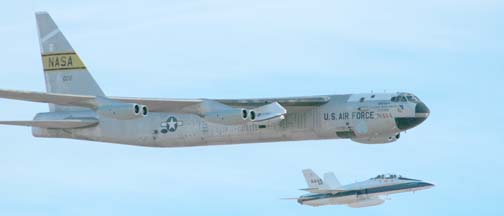 The side of the fuselage of the NB-52B mothership is
dotted with silhouettes representing the many different vehicles and test devices that
it has carried in it's forty-five year long career.
The side of the fuselage of the NB-52B mothership is
dotted with silhouettes representing the many different vehicles and test devices that
it has carried in it's forty-five year long career.
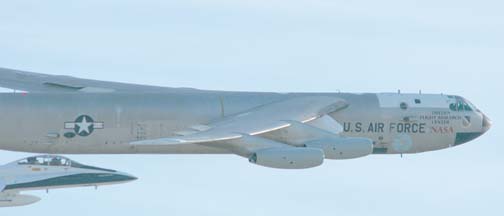 It was the last mission of the
NB-52B mothership, which first
carried the North American X-15 #1 on December 16, 1959. Its first X-15 launch was the first flight of the
X-15 #1 on Janary 23, 1960.
It was the last mission of the
NB-52B mothership, which first
carried the North American X-15 #1 on December 16, 1959. Its first X-15 launch was the first flight of the
X-15 #1 on Janary 23, 1960.
 The NB-52B flew past the rocket test stands on
Lehmann Ridge at the conclusion of its last launch mission.
The NB-52B flew past the rocket test stands on
Lehmann Ridge at the conclusion of its last launch mission.
 The NB-52B flew over Rogers Lake (which actually
has a few inches of water in it right now) as it approached Runway 22 to make a touch-and-go
landing and one more circuit in the pattern.
The NB-52B flew over Rogers Lake (which actually
has a few inches of water in it right now) as it approached Runway 22 to make a touch-and-go
landing and one more circuit in the pattern.
It has been reported that the NB-52B may make one final farewell flight in early 2005.
The X-43A Hyper-X Supersonic Combustion Ramjet testbed is designed to demonstrate a new air-breathing engine technology that will allow flight in the atmosphere at speeds several times faster than the Lockheed SR-71A Blackbird. All current jet engines slow the air moving through the combustion chamber to subsonic velocity by compressing it into a much smaller volume. As the air is compressed, it gets hotter.
As airspeed increases to 3,000 miles per hour and above, the air entering the inlet has to be compressed so much that it is heated to temperatures that will melt the engine. The solution is to allow the air to go through the combustion chamber at supersonic velocity. That way, it does not need to be compressed as much and its temperature isn't as high.
The Supersonic Combustion Ramjet gets its oxygen from the
atmosphere, allowing great savings in propellant weight compared to
rocket engines. SCRamjet propelled vehicles could serve as the first
stage of satellite launching boosters. They could transport passengers,
packages, or other payloads halfway around Earth in just a few hours.
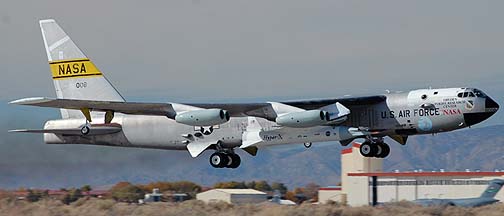 Boeing NB-52B
Stratofortress Mothership.
Boeing NB-52B
Stratofortress Mothership.
link to the NASA Dryden Flight Research Center Fact Sheet for the Hyper-X program.
eBook edition of Balls Eight: History of the Boeing NB-52B Stratofortress Mothership |
||
|
My book Balls Eight: History of the Boeing NB-52B Stratofortress Mothership is now available as an eBook for just $10.99, a considerably reduced price compared to the print edition. It has been asserted that the Boeing NB-52B Stratofortress, carrying Air Force serial 52-0008, can lay claim to being the airplane that has seen and participated in more history than any other single airplane. For forty-five years, the NB-52B was a fixture at Edwards Air Force Base. While the NB-52B is most famous for launching the three North American X-15 rocket planes, it continued to serve in the role of launch platform for a multitude of programs until its final mission, launching the Mach-10 X-43A Hyper-X, on November 16, 2004. It was the oldest flying B-52 by nearly ten years. The eBook edition is profusely illustrated with vintage photographs and diagrams and has more pictures than the print edition. It can be dowloaded directly from Lulu.com. It will soon be available from Apple iBookstore, Amazon, Barnes & Noble, and Kobo. | ||
|
Balls Eight: History of the Boeing NB-52B Stratofortress Mothership |
||
You can buy a 2020 calendar featuring photographs of the Boeing NB-52B Stratofortress Mothership that launched the X-15s in the 1960s and continued launching research vehicles until 2004.
It has been asserted that the Boeing NB-52B Stratofortress, carrying Air Force serial 52-0008, can lay claim to being the airplane that has seen and participated in more history than any other single airplane. This calendar features a dozen pictures of the NB-52B carrying some of the research vehicles that it launched over the years. Photo sources: Air Force, NASA, Richard Lockett, Brian Lockett:
North American X-15-1, 1960
North American X-15-3, 1963
North American X-15A-2, 1967
Northrop HL-10, 1969
Martin-Mariettta X-24A, 1970
Northrop M2-F3, 1972
Martin-Mariettta X-24B, 1973
Orbital Sciences Pegasus, 1989
Supersonic Supercruise, 1995
X-38 V-131R, 2000
X-43A Hyper-X, 2004
 Put a copy of the Balls Eight: Boeing NB-52B Stratofortress Mothership: 2020 calendar in your Lulu.com shopping cart for $14.95.
Put a copy of the Balls Eight: Boeing NB-52B Stratofortress Mothership: 2020 calendar in your Lulu.com shopping cart for $14.95.
 Books about
Lifting Bodies, Edwards Air Force Base, and the X-43 available
from
Books about
Lifting Bodies, Edwards Air Force Base, and the X-43 available
from 
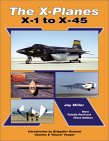 The X-Planes: X-1 to X-45: 3rd Edition
by Jay Miller
The X-Planes: X-1 to X-45: 3rd Edition
by Jay Miller
 Flying Without Wings : Nasa Lifting
Bodies and the Birth of the Space Shuttle by Milton O. Thompson
Flying Without Wings : Nasa Lifting
Bodies and the Birth of the Space Shuttle by Milton O. Thompson
 Test Colors: The Aircraft of Muroc Army Airfield
and Edwards Air Force Base by Rene Francillon
Test Colors: The Aircraft of Muroc Army Airfield
and Edwards Air Force Base by Rene Francillon
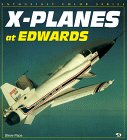 X-Planes at Edwards (Enthusiast Color
Series) by
Steve Pace
X-Planes at Edwards (Enthusiast Color
Series) by
Steve Pace
 Edwards Air Force Base : Open House at the USAF
Flight Test Center 1957-1966 : A Photo Chronicle of
Aircraft Displayed (Schiffer Military History) by Robert D. Archer
Edwards Air Force Base : Open House at the USAF
Flight Test Center 1957-1966 : A Photo Chronicle of
Aircraft Displayed (Schiffer Military History) by Robert D. Archer
 Angle of Attack : Harrison Storms and the Race to
the Moon by Mike Gray. The biography of Harrison Storms, who
was instrumental in the development and operation of the X-15.
Angle of Attack : Harrison Storms and the Race to
the Moon by Mike Gray. The biography of Harrison Storms, who
was instrumental in the development and operation of the X-15.
 At the Edge of Space : The X-15 Flight Program
by Milton O. Thompson. The story of test flying the X-15 from the
point of view of the pilot.
At the Edge of Space : The X-15 Flight Program
by Milton O. Thompson. The story of test flying the X-15 from the
point of view of the pilot.
Send a message to Brian.
Go to home page of the Goleta Air and Space Museum.